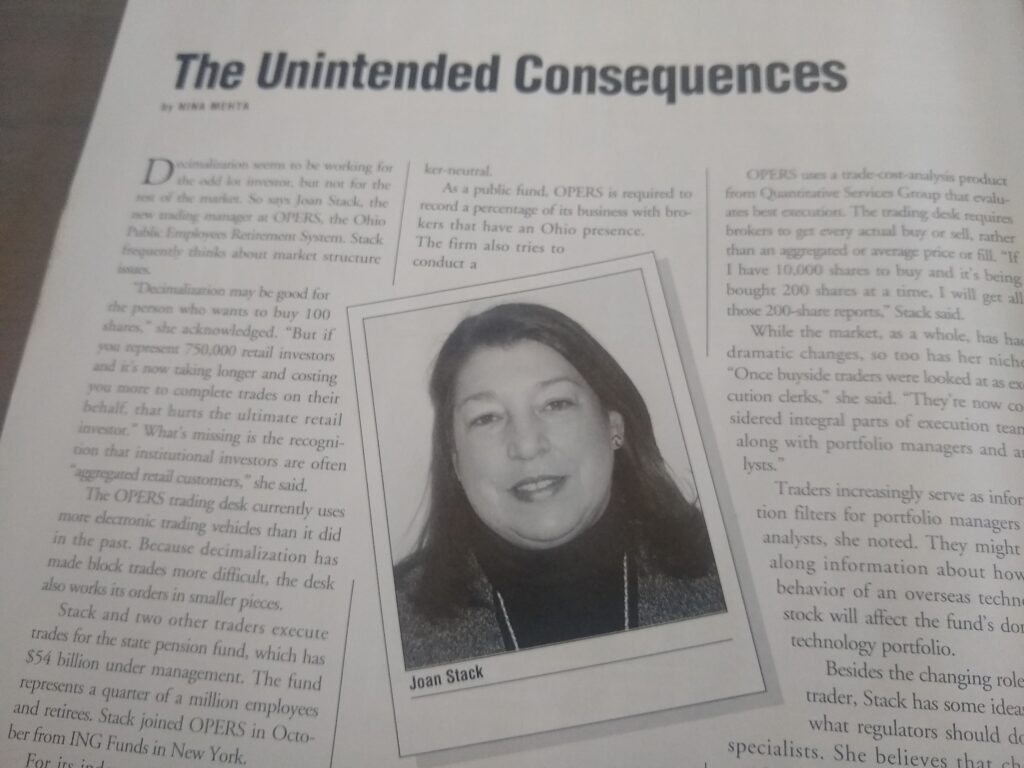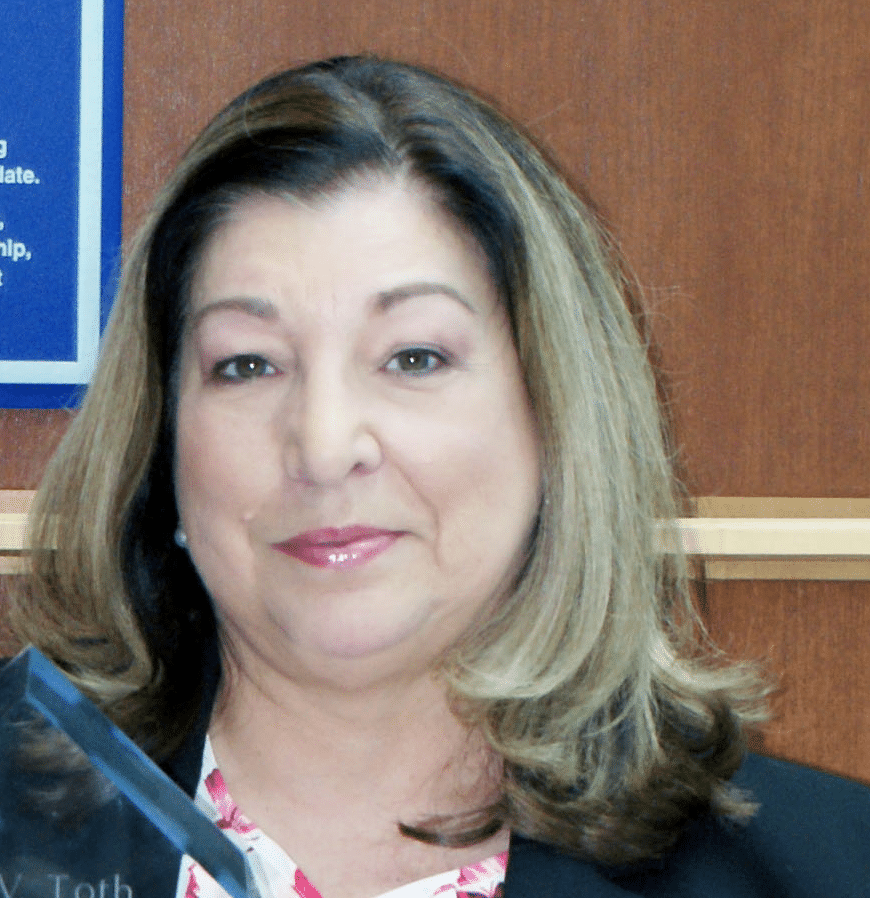This article first appeared as FLASH FRIDAY on Traders Magazine, a Markets Media Group publication. FLASH FRIDAY is a weekly content series looking at the past, present and future of capital markets trading and technology. FLASH FRIDAY is sponsored by Instinet, a Nomura company.
When last sighted in the pages of Traders Magazine, Joan Stack was discussing the unintended consequences of stock-market decimalization in a December 2003 article.

Fast forward 18 1/2 years, and Stack is recently retired from Ohio Public Employees Retirement System (OPERS) where she was Head Trader – Equities for the $91 billion institutional asset owner.
Traders Magazine caught up with Stack earlier this week to learn more about her career and what she’s up to in retirement.
What did you like most/least about being a buy-side trader?
Best: The people! I was privileged to work with some brilliant analysts and portfolio managers over the years and benefited greatly from the camaraderie that developed when working together. And there were so many sell-side professionals willing to share their knowledge and expertise of the ever-changing industry.
Once I landed at OPERS, knowing my efforts could assist our members achieve a secure retirement added meaning to my job
Worst part was in the very early days, as there were so few women in trading roles. I was a vice president and had been on the desk at Bankers Trust for several years. The guys on the BT desk were wonderful to work with and incredibly patient and helpful as I learned the job. Still, when I answered the phone, I’d sometimes hear “Hey honey, give me one of the traders.”
Now I can look back and laugh, but it was very trying at the time!

What were the highlights of your career as a buy-side trader?
Trading during the periods of traumatic upheaval like October ’87, the 9/11 aftermath, and the Covid crash of March 2020. Marshaling the people and resources needed to successfully execute trades and seeing our desk and the industry rise to the occasion. It was exhilarating meeting the challenges.
It was an honor to win WSW Mentor of the Year Award in 2014.
How did the role change over the course of your career?
Tech, tech, tech! My first seat on an equity trading desk had a single screen — an amber on black Quotron. We traders spent the entire day on the phone talking to our portfolio managers, verbally working orders with brokers. There were no order or execution management systems. All the processes were multi-step and manual, there was no straight through processing. When I retired from OPERS last year, I had eight screens on my desk, and probably 95% of my communication was done via Bloomberg chats. Program trading and executing via algo became a huge part of our business over the years.
At OPERS specifically, when I joined in 2003, we only traded US domestic equity in-house. By the time I retired last year, we were trading globally, not only stocks, but options, futures, currencies, and swaps. I know everyone says this about their shops, but I was astounded by how seamlessly we moved to WFH in March 2020.
The rise of rigorous transaction cost analysis and study of market structure moved the needle on trading from being less of an art to more of a science. I believe this brought trading an added degree of professionalism.
What was key to your longevity in the industry?
Flexibility and nurturing relationships. A willingness to take on/learn new markets, products, systems and encouraging other staff to do so. Assisting PMs, analysts, operations staff however I could even if it wasn’t in my job description. Treating junior staff with the same respect and courtesy as the most senior—funny how those assistant PMs blossom into great managers with interesting portfolios and impressive AUM! Earning the confidence of portfolios managers by realizing that PMs value traders who –while offering insights and advice — can adapt to a PM’s preferred trade style.
I would need far too many pages to acknowledge all the people — traders, analysts, PMs, operations and IT professionals — on both the buy and sell side — who helped me along the way to learn and move up the ranks.
But I suppose the single most important factor was that I loved the job.
Do you recall any specific “great trade” or “bad trade”?
Many, but none that make a good story. It was more a case of “you had to be there!”.
What are you doing in your retirement?
I am passionate about civic engagement.
As a founding member of the non-partisan Ohio Matriots, I am working to ensure Ohio’s women have a voice and a seat at the table. When the Matriots formed, Ohio ranked 40th out of 50 states for women in elected office. In 2017 women made up 27.3% of the Ohio General Assembly. That number is now 31.1% with the goal of reaching parity.
Also I volunteer with a few nonpartisan groups to encourage and increase voter registration among young people.
If you are eligible to vote but are not registered, register. And once registered, vote. Your vote is your voice.
Do you still follow the industry closely and/or keep in touch with many people?
Pretty closely — to quote the great Andy Brooks, “The markets get in your blood.” There are some days when I could be persuaded to trade a kidney for a fully loaded, real-time Bloomberg terminal.
I do keep in touch with a handful of people. After 48 years in the business, you form certain relationships that endure.
What would be your advice to a young person just starting out in buy-side trading?
There is so much to learn! Never pass up an opportunity to add a new skill, work on a different asset type or test drive a system. Ask lots of questions. Treat your operations staff and IT associates with respect and kindness; acknowledge their contributions. These folks will save you from trouble more often than you can ever guess.
Bonus Fun Fact: I was interviewed in 2006 along with a bunch of other buy-side traders on our “visions for the future”. My prediction was we’re going to T+1 US equity settlement. And hey, it looks like a mere 17-18 years later I’ll be right!
